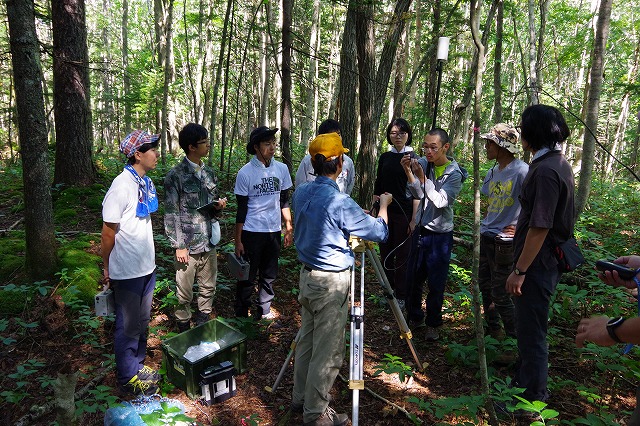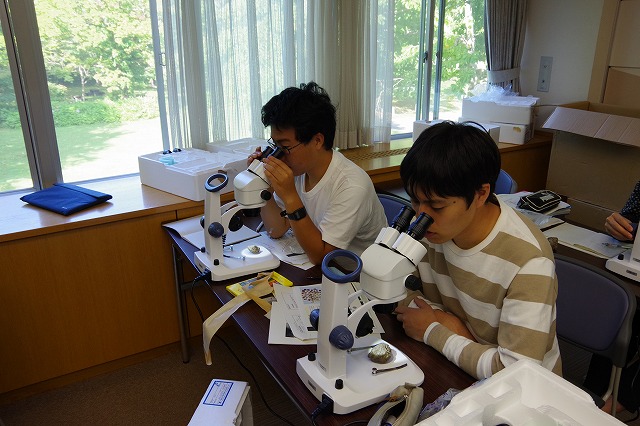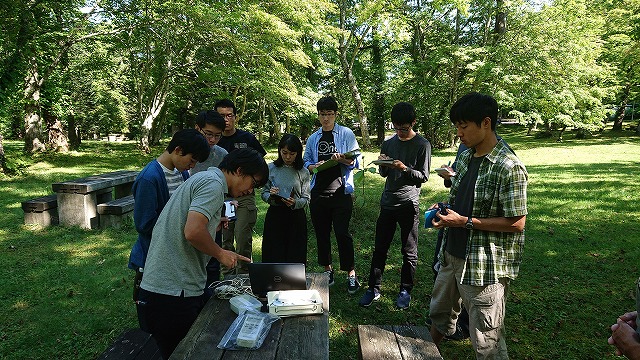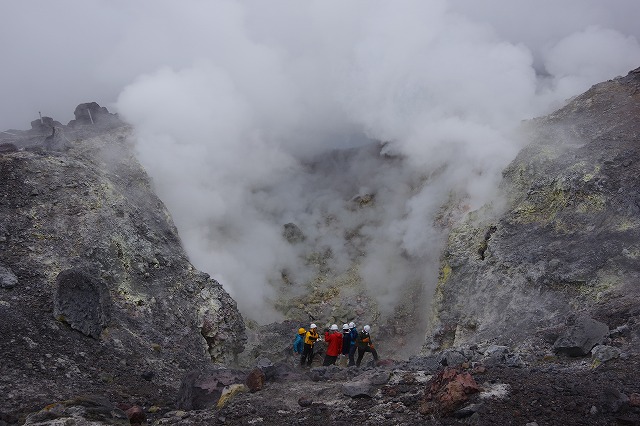
Field studies were conducted at Mt. Tarumae, located near the cities of Tomakomai and Chitose in Hokkaido, over six days, from September 8th to 13th, 2019. A total of 24 graduate students majoring in geophysics and geology/petrology, coming from universities nationwide that participate in this consortium, participated alongside 11 faculty members. In the morning of the second day, the entire group conducted excursions at Mt. Tarumae together. Afterwards, the group was split into the geophysics course (eight members), geology/petrology course (eight members), and geochemistry course (eight members) to conduct field studies, and presentations were given by each group on the final day.


Professor Mitsuhiro Nakagawa (Hokkaido University) provided an overview of Mt. Tarumae from a geological perspective. He gave explanations of features of the Pleistocene volcanic activity of Hokkaido, the Shikotsu-Toya volcanic area, the volcanic history of Shikotsu volcano, the features of the eruptive history and eruption style of Tarumae volcano, and the structure and evolution of the magma system of Mt. Tarumae. This deepened the basic understanding needed for advancing the excursions and field studies conducted from the following day onwards.

The lecture by Professor Takeshi Hashimoto (Hokkaido University) was given with the objective of allowing the students to develop an understanding recent volcanic activity in Mt. Tarumae and the expected risks at the locations to be visited during the field study. Furthermore, explanations were given regarding clues to hint at what is happening underground during the non-eruptive period by reviewing various types of observation data (ground deformation, geomagnetism, volcanic gas composition, etc.).
Guidance was provided by Professor Nakagawa in advance of the mountain climbing excursion. The objectives and significance were clarified for each excursion site, which included a pyroclastic plateau (Fuppushi) and outcrops where volcanic ejecta from the year 1874 could be seen. The students observed differences in the topography and geology of the volcano while climbing the mountain.





Professor Hashimoto lectured geomagnetic observations of volcanoes on September 10th. Afterwards, students were given explanations of observation procedures and learned other basic principles of geomagnetic observations, such as not wearing metals (magnets) during measurements. Students once again climbed Mt. Tarumae after the lecture and began geomagnetic observations. After returning to their accommodations, the students outputted the data from data loggers measured that day and prepared for analyses starting on the following day.
Students took measurements from the station located at the summit of the lava dome on September 11th. The group safely reached the summit despite poor visibility due to fog, and the students successfully gathered data at all stations as planned. After returning to their accommodations, the students were given a lecture and explanations from Professor Hashimoto regarding the basic principles of estimating underground geomagnetic sources from surface geomagnetic observation data, as well as the relevant analytical methods.
On September 12th, the group was split into two parts, and each estimated the location of the underground geomagnetic source using the geomagnetic observation data obtained.





Professor Nakagawa gave a lecture titled "Introduction to volcano geology" on September 10th, after which the students observed outcrops of pyroclastic materials brought about by a large-scale eruption (VEI5) at Okarasawa in 1739. After receiving an explanation from Professor Nakagawa, the students classified the sediments into layers, measured the layer thicknesses and the pumice size, and created a columnar section of the outcrop.
On September 11th, the students investigated the northeastern foot of Mt. Tarumae and observed the structure of the pyroclastic flow and the features of the pumice from the mid-scale magmatic eruption that occurred in 1874, which can be seen on top of the volcanic ejecta from the large-scale pyroclastic flow in 1739. Furthermore, the students studied how to distinguish pyroclastic flow deposits within strata, as well as the welding of pyroclastic flow deposits thought to be due to the effect of topography.


On September 12th, the students conducted microscopic observations in the classroom, under the guidance of Assistant Professor Shumpei Yoshimura (Hokkaido University), of pyroclastic materials collected during the previous two days, and made estimates of the depth of the magma chamber based on the formation conditions of the minerals. Furthermore, the pumice density was measured using its mass and volume, and the depth of the magma fragmentation level formed by the pumice was estimated.


On the morning of September 10th, Chief Researcher Hiroshi Shinohara (National Institute of Advanced Industrial Science and Technology) lectured the origin of volcanic gas composition, as well as multi-component equilibrium calculations and Multi-GAS. Next, Dr. Masaaki Morita (National Institute of Advanced Industrial Science and Technology) lectured measurements of volcanic gas composition and emission rate. In the afternoon, students conducted calibration and investigated response characteristics of the equipment to be used in the field study for the next day. On September 11th, the students climbed Mt. Tarumae and used a portable UV spectrometer and Multi-GAS to measure volcanic gas composition near the A-crater.


On September 12th, the students analyzed the observation data obtained on the previous day. The students used data to quantitatively estimate chemical components such as H2O, CO2, and H2S contained in volcanic gas.




On the final day, September 13th, students gave presentations that summarized the field study. Two groups were formed from each of the geophysics, geology/petrology, and geochemistry course groups for oral presentations of the field study results, and a lively question and answer session was held for each group's presentation. Finally, the professors gave comments for the work.